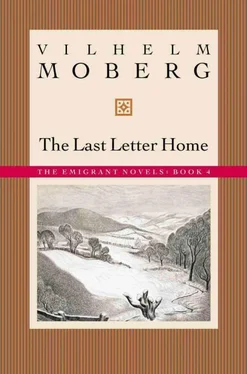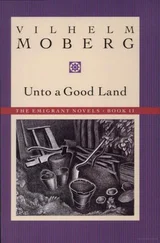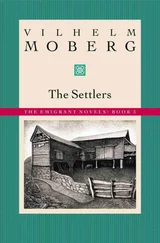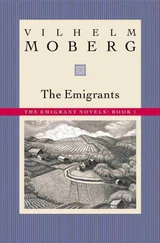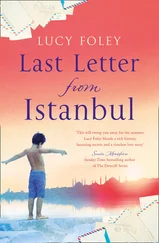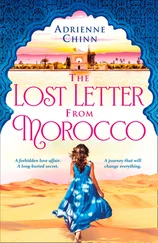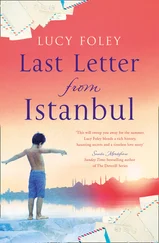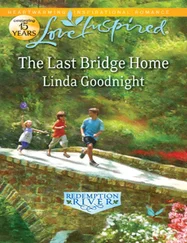Charles O. Nelson from Ljuder in Sweden would die here in America, he would die on the Nelson Settlement, in this house, in this room, in the bed where he now lay.
Seeking to escape his merciless torturer, his finger moved again over the old map, back and forth, up and down. It found the red county road and stopped at a crossing.
Here a group of people had met one cold April morning — several drivers, with heavy loads, men, women, and children; altogether sixteen of them. Their wagons had been loaded with baskets and bundles, sacks and satchels, like a gypsy pack, as they rolled south to Karlshamn. Those people were to travel a long road, they were leaving their homes for the last time, and he was one among them.
It had frosted over during the night, the ruts were icy and creaked and crunched under the wheels. People looked through the windows at the travelers. He is sitting on the front wagon, looking at this village for the last time. He looks carefully, searching for details, he wants to remember this place and that, for they were part of his childhood and youth; this is a farewell drive.
And now he is back in this village again, the map in his hands comes to life, filled with people and animals; he remembers who lived in each house, the cattle of each field. The mowers swing their scythes, the women their rakes, the hayricks rock on the narrow roads and leave tufts in branches and bushes along the wayside. He can hear the cowbells tinkle from the wastelands, he can hear sounds of busy tools in the houses and outside; scythes singing against grindstones, axes clanging against wood, flails against the barn floor, spinning and spooling wheels in cottages and kitchens.
Then he sees her and he recognizes her at once.
She is seventeen and she is busy at a spindle. She has flaxen hair and kind eyes, rose-hued cheeks, and a few freckles on her nose, like wild strawberries not yet ripe. He has met that girl before and never has been able to keep his eyes off her. She is very shy, she blushes when she turns toward him. He doesn’t want to embarrass her but he can’t help it! He looks at her again and she turns peony-red.
Now he has found the Klinta fair. Here he had agreed to meet the girl of the spindle. For two springs and one autumn he meets her here.
And where is the road that leads to another village, the road he has tramped so many times, walked so willingly through the nights? A long road, but short to him, shorter each time he walks it, he knows it so well, every curve, every hill, every gate. He walks it with easy feet, he runs when late, in a hurry. He is on his way to a gate before a house in a neighboring village, there she’ll be waiting, in a light-blue shawl; she has promised to wait if he’s delayed.
He searches for that road on the map, he knows he’ll find it, the road to the woman who will be his wife. .
Nowadays he goes to the cemetery, a few times each year, to visit her. In summer the road is easy; in winter he must stay home.
He had been to visit her a few days ago. Johan had an errand in that direction and he used the opportunity to ride along. The August day had been just right, not too warm; later in the evening it rained.
Before he journeyed to Kristina he washed and dressed with special care. He shaved and combed his hair just right. He put on a clean shirt and his Sunday-best suit, a starched collar. And he shined his boots. It took him a long time to get ready, what with his stiff back and lame leg. But he prepared himself as if he were going to a wedding or some important gathering.
It was barely two miles to the Swedish cemetery, only half an hour with the team.
Charles O. Nelson was usually alone when he visited his wife, and he was alone this time also. He climbed off the wagon outside the cemetery gate; Johan would pick him up after a couple of hours.
It was a calm day. The sun warmed but did not burn. It was shady and cool under the trees in that place set aside for the dead. A new fence had been put up, good-looking, rails stripped of bark glittered clean and white around the home of the dead.
Leaning on the stick in his right hand he limped up to the gate, opened it, and walked inside. Above the entrance a white-painted board had been put up, with an inscription in black:
Blessed are those who here sleep.
Eternal Peace is Death’s Gift.
Each time he came to the gate he would stop and read the inscription, as if wishing to assure himself that not a letter had been changed since last time.
The cemetery sloped toward the shore cliffs and below them the sky-blue lake began. On three sides this little peninsula was washed by the lake water. Stately, lush silver maples shaded this last resting place, a joy to the eye on a summer day like this.
Charles O. Nelson, leaning on his stick, slowly shuffled his way along the path between the graves. No other visitor was in sight today. He knew this place well, it was a long time since he had buried his wife here, and he recognized everything. The graves lay in straight rows, some with fresh flowers, others neglected, overgrown with weeds; others again had dry, withered flowers in overturned pitchers or ordinary drinking glasses; on some not even weeds grew.
He had once been among those who selected this place as the burial ground of the Swedish parish. Four of them had gone out a morning in June to choose a plot suitable for the dead. They had come onto this little promontory at the old Indian lake, Ki-Chi-Saga, and had sat down to rest under the silver maples. They did not have to seek any further; their mission was accomplished.
Three of the four now had their graves in this place, three had been lowered into the ground they themselves had chosen as their last resting place. But the fourth was still alive, walking here between the graves. He moved with great effort, he took one long right step and two short left ones. Surely no one moved more slowly over the earth than the fourth man who today visited here.
The first years very few graves had been dug. The immigrants were mostly young people, the greater part of their lives before them. Yet, the very first grave had been opened for a young person, Robert Nilsson, aged twenty-two. But the years ran by, time did its work, the parish members grew old and the hour of death caught up with them. By and by the rows of graves grew longer.
Here lay all those who were older than Karl Oskar at the time of their emigration, and many of his own age group had already moved here. He recognized the mounds. The longest life had been granted to Fina-Kajsa, but she had been old when she arrived in America. Jonas Petter had been almost fifty when they came and had lived to a great age. Only a few years ago had his grave been dug; it was still the last to have been opened for one of his Old Country friends.
The dead had been laid in their coffins, their faces toward the east, toward the rising sun, for it was in the eastern sky that Christ would come on the day of resurrection. Their faces must be turned toward their Redeemer so their eyes could see him at once.
Karl Oskar stopped, resting his left leg as he leaned on the stick, blinking in the sun. Kristina’s grave was a few hundred paces from the gate, he would soon be there — about thirty more steps. He could already see the cross he had raised over it. The grave was halfway down the slope under a wide-spreading silver maple.
At a distance of a few paces he stopped and read the words he had carved in the oak cross:
HERE RESTS
KRISTINA JOHANSDOTTER
Wife of Karl Oskar Nilsson
Born at Duvemåla, Sweden 1825
Died in North America 1862
WE MEET AGAIN
On the grave he had planted sweet williams, blue doves, and marigolds, some of the flowers Kristina herself had planted at Korpamoen in Sweden. He tried to keep the grave well attended but weeds were sticking up among the flowers and he bent down to pull them.
Читать дальше
